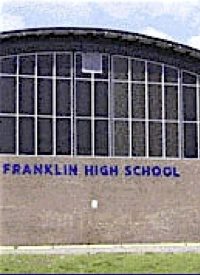
A partially burned American flag appearing as part of a student art exhibit has drawn opposition from a Veterans of Foreign Wars commander in Franklin, Massachusetts. But school officials have defended the display as a student’s exercise of his freedom of speech.
"Free expression and the right to dissent are among the core principles which the American flag represents," School Committee Chairman Jeffrey Roy and school district officials said in an e-mail to the Milford Daily News. "And this freedom applies even to the thoughts that we may hate." School officials did not identify the student who made the display of an American flag, burned on the edges, for the annual senior art show that ran at Franklin High School from May 12 through May 21 without incident, the paper reported. But Larry Bederian, commander of VFW Post 3042 said he was unaware of the display until he found a pair of photos in his mailbox. A photograph accompanying the story in last Saturday’s Daily News shows Bederian, 63, holding two photos — one of a young person holding a match under an American flag and the other of the burnt flag on display in the student art exhibit.
"I don’t think it is right, especially at this time of the year," Bederian told the paper. "It brings back a lot of hard memories," said the Marine Corps veteran who served in the Vietnam War. He showed the photos to people at the Memorial Day breakfast at the local Elks Lodge. One of them, state Rep. James Vallee, expressed both his disappointment and outrage.
"I am deeply disappointed that anyone would use that as a form of art," Vallee said. "Quite frankly I am outraged by that fact."
Bederian met with school officials on Friday and was told that the exhibit was accompanied by a disclaimer. According to the e-mail sent to the newspaper, the disclaimer read: "Franklin High School and the Franklin Public Schools recognize and support the right to symbolically represent free speech as provided by the First Amendment of the Constitution and upheld by the Supreme Court. However, the opinions expressed in this artwork do not represent Franklin High School, The Franklin Public Schools, The Town of Franklin, the art department, any teacher or individuals other than the artist." In the same e-mail message, the school officials said: "While the content of the piece may have been perceived as disrespectful or inflammatory this was not the intent of the artist. Indeed, the piece was intended to speak of the erosion of the American dream for some individuals in this country."
Flag burning as a freedom of speech issue surfaced in the 1960s, when protests against the Vietnam War sometimes included the burning of an American flag. Congress passed the Federal Flag Desecration Statute in 1967 and various states, either before or during that time, had also enacted laws banning the burning, mutilation or desecration of the flag. Symbolic speech was also an issue in another much publicized form of protest in that era, the burning of a draft card. In U.S. v O’Brien, the Supreme Court upheld the conviction of a draft card burner who claimed his demonstration on courthouse steps in Boston was protected by the First Amendment. The court ruled that the government had a legitimate interest in forbidding the mutilation or destruction of the cards and in requiring draft registrants to carry them at all times to ensure the proper functioning of the military draft. Chief Justice Earl Warren, writing for the court, drew a distinction between speech and conduct and rejected "the view that an apparently limitless variety of conduct can be labeled speech whenever the person engaging in the conduct intends thereby to express his idea."
The following year the Court, in Street v New York, overturned the conviction of a flag burner under a New York law, claiming it was unclear whether the defendant had been convicted for the flag burning alone or the incendiary words he uttered at the time. The court ruled that the verbal speech was constitutionally protected, but left unanswered the question of whether the public flag burning was covered by the First Amendment. In a dissenting opinion, Justice Hugo Black argued the court should have affirmed the state’s ban on flag burning. "It passes my belief that anything in the Federal Constitution bars a State from making the deliberate burning of the American Flag an offense," Black wrote. In a separate dissent, Chief Justice Warren declared, "I believe that the States and Federal Government do have the power to protect the flag from acts of desecration and disgrace," adding it was "difficult for me to imagine that, had the Court faced this issue, it would have concluded otherwise."
But 20 years later the Court did face the issue and did conclude otherwise in the 1989 case of Texas v Johnson. In a highly controversial 5-4 decision, the Court overturned the conviction of a man who publicly burned a flag during protests surrounding the Republican National Convention in Dallas. In overturning the Texas law, the Court rejected the argument that the ban on flag desecration was consistent with the state’s legitimate interest in preventing breaches of the peace. Associate Justice William Brennan, writing for the majority, said: "Johnson’s conduct did not threaten to disturb the peace. Nor does the State’s interest in preserving the flag as a symbol of nationhood and national unity justify his criminal conviction for engaging in political expression."
In a lengthy and impassioned dissent, Chief Justice William Rehnquist, argued that rather than symbolic speech, "flag burning is the equivalent of an inarticulate grunt or roar" intended not to "express any particular idea, but to antagonize others." The flag as a symbol of our nation, said Rehnquist, has "a uniqueness that justifies a government prohibition against flag burning…."
The ruling created a national uproar and a number of attempts have since been made to pass a constitutional amendment to ban desecration of the flag. None, however, has made it through Congress. Sen. Charles Grassley (R-Iowa) was among those backing such an amendment last year, arguing that, "if you read the debate in 1790 — the First Amendment was not written to protect nonverbal speech…." Grassley wanted to "get the Constitution back to its original intent before the Supreme Court screwed it up."
But for now at least, court rulings have left flag burning as a "constitutionally protected" exercise of the freedom of speech, as it is apparently taught at Franklin High School in Franklin, Massachusetts, and, no doubt, in other schools throughout the nation.



